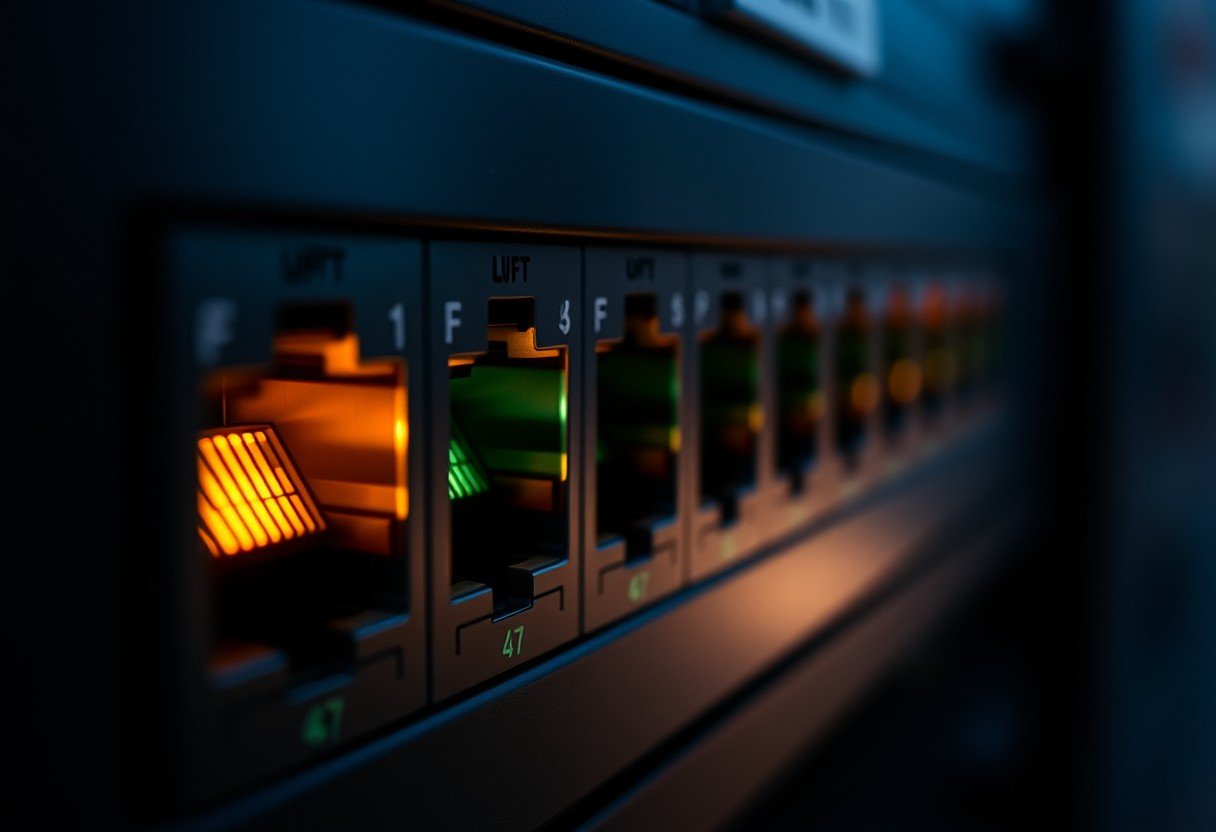Seeing some FastEthernet ports on your switch blinking green while others are dark can be frustrating for any network administrator. This common issue can disrupt connectivity and slow down your entire network. The cause often lies in simple physical connection problems, incorrect configuration settings, or even faulty hardware. Understanding how to diagnose these discrepancies is the first step toward restoring full network functionality and ensuring smooth, reliable performance for all connected devices.
First Steps: Inspecting Physical Connections
Before diving into complex software configurations, always start with the physical layer. A surprisingly high number of network issues stem from simple physical problems that are easy to overlook but also easy to fix. This is the foundation of your network, and if it’s not solid, nothing else will work correctly.
Begin by checking the most obvious culprit: the network cable. Ensure it is securely plugged into both the switch port and the end device. A loose connection is a frequent cause of port inactivity. Look at the port’s link lights. Typically, a solid green light indicates a healthy connection, while an amber or unlit light signals a problem that needs investigation.
Don’t assume a cable is good just because it looks okay. Cables can suffer internal damage that isn’t visible from the outside. Try swapping the problematic cable with a known working one. If the port comes up, you’ve found your problem. Also, inspect the port on the switch and the network interface card (NIC) on the device for any physical damage like bent pins.
The Role of Configuration and Management Settings
If the physical connections are secure, the next place to look is the switch’s configuration. A port can be perfectly healthy from a hardware perspective but disabled in the software. This is often done for security reasons or during network changes and can be easily forgotten.
One of the most common configuration issues is a port being “administratively down.” This means a network administrator has manually issued a `shutdown` command on that specific port interface. You must enter the interface configuration mode and issue a `no shutdown` command to bring it back online.
Other settings can also prevent a port from becoming active. These include:
- VLAN Assignments: If a port is assigned to a VLAN that doesn’t exist or is not configured correctly on the trunk links, it may not function as expected.
- Port Security: Features like port security can disable a port if an unauthorized device is connected or if the maximum number of MAC addresses is exceeded.
- Spanning Tree Protocol (STP): In some cases, STP might block a port to prevent a network loop. While this is normal behavior, it can sometimes indicate a design flaw or misconfiguration.
Regularly auditing your switch configurations is crucial for preventing these types of issues from causing unexpected downtime.
Common Misconfigurations and How to Solve Them
Beyond a port being shut down, specific mismatches in configuration between the switch and the connected device are a primary source of connectivity failures. These subtle errors can lead to intermittent connections or cause a port to remain down entirely.
The most frequent culprits are speed and duplex mismatches. FastEthernet can operate at 100 Mbps and in either half-duplex or full-duplex mode. While auto-negotiation usually handles this, problems arise when one side is set to auto-negotiate and the other is manually configured. This mismatch can cause severe performance degradation or prevent a link from being established at all.
To resolve this, ensure both ends of the connection are either set to auto-negotiate or are manually configured with the exact same speed and duplex settings. You can check these settings using the `show interface` command on most managed switches.
| Setting Mismatch | Symptom | Solution |
|---|---|---|
| Speed Mismatch (e.g., 100Mbps vs 10Mbps) | Port remains down; no link light. | Set both devices to auto-negotiate or manually configure them to the same speed. |
| Duplex Mismatch (e.g., Full vs Half) | Port is up but experiences high error rates, collisions, and slow performance. | Set both devices to auto-negotiate or manually configure them to the same duplex mode. |
| VLAN Mismatch | Port is up, but device cannot communicate with the network. | Ensure the port is assigned to the correct VLAN and the VLAN exists on the switch. |
Essential Tools and Commands for Troubleshooting
To effectively diagnose port issues, you need to be familiar with the command-line interface (CLI) of your switch. A few simple commands can provide a wealth of information about the status of a port and the overall health of your network.
Start with basic connectivity tests. The `ping` command helps verify reachability to the connected device’s IP address, while `traceroute` can show you the path data is taking. If these fail, it’s time to look at the switch interface itself.
The `show interface status` command is one of your most valuable tools. It provides a quick, tabular overview of all ports, their status (connected, notconnect, disabled), VLAN, duplex, and speed. This allows you to spot anomalies at a glance. For more detailed information, including error counters and input/output statistics, use the `show interface [interface-name]` command.
Don’t forget about physical tools. A simple cable tester can quickly identify faulty wiring within a network cable, saving you hours of troubleshooting. For larger networks, a network monitoring system can proactively alert you to changes in port status, allowing you to address issues before users even notice.
The Impact of Port Status on Overall Network Performance
It might seem like a single inactive port isn’t a major issue, especially on a switch with 24 or 48 ports. However, down ports can have a significant ripple effect on your network’s performance, reliability, and redundancy.
When ports are down, traffic that would normally use those connections must be rerouted through the remaining active ports. This can create bottlenecks, where a few ports become overwhelmed with traffic, leading to increased latency and slower data transfer speeds for everyone. This is especially true if the down port was connected to a critical device like a server or another switch.
Furthermore, inactive ports can eliminate redundancy. Many networks are designed with multiple pathways for data to travel. If a primary link fails, traffic can automatically switch to a secondary path. If that secondary port is already down due to a misconfiguration or cable issue, you have a single point of failure that could bring down an entire segment of your network.
Best Practices for Maintaining Healthy Network Ports
The best way to deal with port issues is to prevent them from happening in the first place. Adopting a proactive approach to network management can significantly reduce downtime and improve the overall stability of your infrastructure. This involves regular maintenance, thorough documentation, and a structured approach to making changes.
Consistent monitoring and documentation are the cornerstones of a reliable network. By keeping accurate records of your switch configurations, VLAN assignments, and physical cabling, you create a valuable resource for future troubleshooting. A structured change management process ensures that any modifications are planned, tested, and documented, reducing the risk of accidental misconfigurations that could bring down ports.
Here are some key practices to implement:
- Regularly Audit Configurations: Periodically review the running configuration of your switches to ensure they align with your network standards and to catch any unauthorized changes.
- Label Everything: Clearly label all cables, ports, and devices. This makes tracing physical connections during troubleshooting much faster and easier.
- Use Network Monitoring Tools: Implement software that can monitor port status, traffic levels, and error rates in real-time, alerting you to potential problems.
- Keep Firmware Updated: Switch manufacturers regularly release firmware updates that can fix bugs and improve performance, including issues that may affect port stability.
Frequently Asked Questions about Switch Port Status
Why is my switch port light amber instead of green?
An amber light often indicates that the port is blocked by the Spanning Tree Protocol (STP) to prevent a network loop, or it could signify a non-passing diagnostic test during boot-up. It’s a sign that the port is active but not forwarding data normally.
What does it mean if a port is “administratively down”?
This status means a network administrator has manually disabled the port using the `shutdown` command in the switch’s configuration. The port is physically fine but has been turned off in the software and will not pass traffic until it is re-enabled with the `no shutdown` command.
Can a faulty device cause a switch port to go down?
Absolutely. If the network interface card (NIC) in the connected computer, printer, or server is malfunctioning or if the device is powered off, the switch port will show a “down” or “notconnect” status because it cannot establish a valid link.
How do I fix a speed and duplex mismatch?
The best practice is to set both the switch port and the connected device to “auto-negotiate” for speed and duplex. If that doesn’t work, you must manually configure both ends to the same setting, for example, 100 Mbps and full-duplex.
What is the very first thing I should check when a port is down?
Always start with the physical layer. Check that the cable is securely plugged in at both ends and examine the port’s link light for any activity. Testing with a different, known-good network cable is also a crucial first step.









Leave a Comment